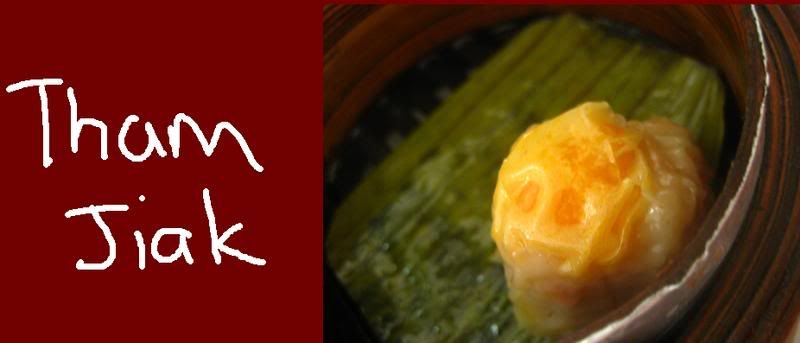Monday, June 21, 2010
Uniquely Mixed
Friday, May 07, 2010
The Many Sides of Manila and It's Food

A cross between the crunchy and the soft, a lot of people's favourite:
Gerry's Grill
Glorietta 5
Level 2, Ayala Center,
Makati City, Metro Manila
(02)856-4443, (02)856-3544
Sunday to Thursday 11am - 12midnight
Friday and Saturday 11am - 2am
Other Branches
Tuesday, July 31, 2007
Bangkok: Cooking School
 I finally succumbed to it. I went for a cooking course in Bangkok. The idea had flit through my mind on and off, whenever I read through a blog, browsed through a food site or flipped through a magazine. I would be not fair to myself and my blog readers if I do not go and learn the secrets of Thai Cooking right?
I finally succumbed to it. I went for a cooking course in Bangkok. The idea had flit through my mind on and off, whenever I read through a blog, browsed through a food site or flipped through a magazine. I would be not fair to myself and my blog readers if I do not go and learn the secrets of Thai Cooking right?I researched the net for the cooking school that would suit me, finally settling for Silom Cooking School because it has the most reasonable price with good review as well. Extra bonus is that it includes local market shopping beforehand.
My cooking instructor, N, a really sweet guy, guided me to his place and paid for the fare as well as he could not pick me from my busy hotel at Sukhumvit road.Once there, I joined up with a family from Hong Kong, a lady with her husband, daughter of six and mother (or in-law, I’m not sure). They are really a nice bunch and it was great fun learning cooking with them.
The first session was we head straight to a small local market near N’s place. First thing we bought is freshly grated coconut for our curries. Then N proceeds to explain the various kinds of curry paste used in Thai cooking. He says that there are 3 common curry pastes: green, red and yellow. All are nearly the same except that green paste is made from fresh green chillies while the red paste is from dried red chillies and the yellow paste added with turmeric for color. It does sound simple the way he said it.

Then we head out to the vegetable stall, where it seems like N’s usual place to go for the students as the lady at the stall knows what to get for him straight away. She was also oblivious to N poking at her vegetables while explaining to us about it. N explained various Thai herbs to various gingers as well as various eggplants.

Each of us had a little basket to do our market shopping. Here is my bountiful basket herbs and spices:

After that we lug our basket of treasures back to his place. I was impressed by the beautiful cooking place setup.

Everything was nicely plan, with one room for wet preparation, such as pressing coconut juice included with a place to wash the vegetables.

Another room was for the dry preparations such as cutting, pounding and so on. At the dry preparation, we are all rationed from the tray with what is needed to cook our one-portion dish. Then N showed us what to do with it.
Then we head out with our tray and do some cooking. Here is my final own cooked version of Tom Kha Gai (coconut milk chicken). It is my first time eating this dish so I can’t judge with the authentic ones out there, but this soup is definitely a filling one. I could not finish the coconut milk.
Next I dished up another one-person portion of Gai Pad Med Mamuang (Fried Cashew Nut with Chicken).
Then N explained on various Thai rice and how each is cooked and consumed. Then he proceeds to show how they traditionally steam the sticky rice.
Next N showed us how to make Yam Wun Sen (Spicy Mungbean Noodle Salad). It is served nicely presented with the now-cooked sticky rice.
Next we shared make Thod Mun Pla (Fried Fish Cakes). The process was a bit messy but the finish product, once again nicely presented by N, was definitely a delicious sight and delicious to eat as well. We also get to make the Thai Sweet Chilly Sauce to accompanied it ourselves.
Next we prepare the red curry paste and then dished up Kang Phet Gai (Red Curry Chicken).
Finally, courtesy from N as I requested, he taught me how to make Som Tam. How can I missed this beloved dish right? I get to pok-pok the salad together. Turn out it is really simple, now I am going to go against what I preach, and make one for myself at home soon.
So that’s the end of my experience in Silom Cooking School. I had tremendous fun and would like to thank N for the wonderful dishes and expanded waistline. N also gave us his own compiled recipes before we leave, how thoughtful. So what is the secret of Thai cooking? The secret lies in fresh local ingredients. That’s all really. Everything else is really simple and easy, especially if you know Asian way of cooking. Now when am I going to make these dishes at home as I promised to J?
Friday, July 13, 2007
Som Tam: How much do I love thee?







Som tam (Thai/Isan ส้มตำ) is a spicy papaya salad originating in Laos and the Isan region of northeastern Thailand. Som (ส้ม) in Isan and Lao means "sour," and tam (ตำ) means "pounded." - wikipedia
There is so much to say about this simple wonder salad. The Isaan region tends to have quite a number of wondrous food and this is definitely the cream of their crop. I never know about how good Som Tam can be until I tasted one myself in Thailand. I can eat this everyday as a staple diet if needed. Maybe then I will be as slim as most of the Thai people here. There is just something in their food which a generally slim society even when sugar are consume in excess. Don’t get me ranting on that, maybe in the next post, now it is all about Som Tam.
Unfortunately, I know that it is near impossible to replicate this dish anywhere else outside of Thailand unless you have all the ingredients air flown to you fresh and you somehow learn the art of making Som Tam. Here are the reasons:
Young papaya:
First, the freshly grated papaya is important. Grated is not exactly the word as I see the Thai chefs skillfully chopped the whole papaya in their hands, and then slice them nicely, where all the papaya falls miraculously into same-sized strips. Believe me, they do it way better than any grater or food processor can ever do. I always stand there in fascination when they prepare it. So maybe if you do it in a machine, it will never be as authentic. Maybe if I’m lucky I can learn up the skill, without losing a few fingers. But first to get hold of these huge green young papayas.
Sauce
Then the important lime juice in the sauce, using Thai rounded green limes that seem to be only found here is an extreme point in the sauce key tanginess. The sauce also uses palm sugar, fish sauce and thai chillies.
Peanuts
Plus to me, a Som Tam is never complete without its freshly fried peanuts, where I found is way much better than the varieties in Malaysia. Here they have these not too big and light peanut that they had roasted to perfection. Slight hint of black spot ones are the most fragrant.
Everything else
It is also important to have the baby tomatoes, halved added into the Som Tam. I also usually call the most general version of Som Tam which adds in dried shrimps for taste.
Raw vegetables
Well this one I guess you can get it here in Malaysia, generally we eat with raw cabbages and winged beans, sometimes with basil leaves and spring onions. It is really fun eating raw vegetables dipping in som tam sauces.
Utensils
Oh and not to forget one must have the Thai mortar to ‘pok pok’ your som tam together. It is essential indeed for the authentic taste. This mortar is not to be confused with our Chinese mortar and pestle, as the mortar is made of ceramic and the pestle made of wood. It is much deeper to fill in all the som tam ingredients. But if you insist, or you are desperate (I might someday), I found a few recipes which seemed promising:
Real Thai Recipes
Blue Elephant Recipe
Thai Info-net
For the love of Som Tam, I must have it every time I am in Bangkok. If I have a choice, I would have it for every meal even. As far as my love for Som Tam goes, I will stuff my mouth with it as much as possible before my chances of having the authentic ones in Bangkok itself ran out. This is definitely one dish I would miss.
Friday, June 29, 2007
Bangkok: Sneaky Lunch Post
 I had Kanom Jeen for lunch. You can read all about it here in Eating Asia, where Robyn did a great justice to it. For me I am ‘suppose’ to be doing a quick post here. My time now is still ‘paid’, and not to write for sure.
I had Kanom Jeen for lunch. You can read all about it here in Eating Asia, where Robyn did a great justice to it. For me I am ‘suppose’ to be doing a quick post here. My time now is still ‘paid’, and not to write for sure.This lovely spicy noodle came with arrays of fresh veggies (very good for a health freak like me). Fresh vegetables are ubiquitous here in Bangkok, the total opposite of Malaysia.
After the lunch, which is located in the market, we had a walk past the stalls selling various foods. My eyes feasted greedily from here to there, mouth watering and hands firmly holding my camera. The locals there must be confused, as I usually look like a local, and pretend like one most of the time, mumbling few Thai words as if it is my mother tongue.
 My colleague got intrigued with this stall and ask for two ‘balls’ which was then pick up, smashed up and mixed with everything else and then passed to my bewildered colleague. This is her two fried balls, now a smashed ‘rojak’.
My colleague got intrigued with this stall and ask for two ‘balls’ which was then pick up, smashed up and mixed with everything else and then passed to my bewildered colleague. This is her two fried balls, now a smashed ‘rojak’. Anyway, as we are about to leave, we got called on by a lady to buy her sweets (I checked with my Thai friend here, it is called Ka Lak Meh, made of rice flour and sugar). She look so cute, marketing non-stop on her sweets, smiling so innocently, it got right to my heart. These are people who make me feel soft at the heart, and to know that not everybody has comfortable life. I told my colleague, how much can she get selling 1baht (10 cents) per piece of sweet, she need to sell at least 20 sweets to get a kanom jeen for lunch. With chance, I will surely go back there again and buy more from her.
Anyway, as we are about to leave, we got called on by a lady to buy her sweets (I checked with my Thai friend here, it is called Ka Lak Meh, made of rice flour and sugar). She look so cute, marketing non-stop on her sweets, smiling so innocently, it got right to my heart. These are people who make me feel soft at the heart, and to know that not everybody has comfortable life. I told my colleague, how much can she get selling 1baht (10 cents) per piece of sweet, she need to sell at least 20 sweets to get a kanom jeen for lunch. With chance, I will surely go back there again and buy more from her.
Wednesday, January 31, 2007
Bangkok Food Post: A-Roi
 How long since I have abandon this blog? I guess we better skip the I’m-so-sorry part and get right down to business. Yes I’ve been to Bangkok once again, if any of you have guess with me missing in action, and work life has just been busy. So I have to be short here. No matter how much I love to write, sometimes I do agree to some degree that picture speaks louder than words.
How long since I have abandon this blog? I guess we better skip the I’m-so-sorry part and get right down to business. Yes I’ve been to Bangkok once again, if any of you have guess with me missing in action, and work life has just been busy. So I have to be short here. No matter how much I love to write, sometimes I do agree to some degree that picture speaks louder than words.I have been contemplating for a long time on how to present all the wondrous food of Bangkok that I had in my long-stay two times trip here. There is just so much to talk about from fresh fruits to som-tum to porks (which seems like the main meat here in contrast to Malaysia, where it is the universal white meat – chicken). Nonetheless, chicken will be featured here too of course, albeit in dimmer limelight, but still not forgotten.
Here I go again, launching into ranting when I have just said I want to let pictures do the talking. I can’t resist it. I am a writer at heart squeezing in beside my tham-jiaknes. Anyway, for the Bangkok foods, I have tried searching around for proper info in the food I ate, its name and how it was made, but nonetheless, it was too many and much cannot be found on the web. Appreciate if any of you out there knows about it, would drop some comments for all of us to share.
Now I would kick-off my Bangkok food posts with street-snacks:
As I found out soon, all snacks in Thailand are of 10 baht, equivalent to RM1 in Malaysia. Everything is 10 baht, from fried stuff to ice cream to peanuts and to fruits and to even my favourite coconut. We find it cheap as the portion are usually very generous.
First up is my favourite snack from the street side vendor. It is called Kanom Kai Noak Garta, which are actually fried sweet potato balls. Crunchy and sweet at the same time, very moreish.

Then we have the Kanom Krok, which is actually coconut pancake, cooked in special pan. It is sweet, for the plain ones, and slightly savoury with the addition of the green onions. I welcome the taste of the spring onions as it brings this tiny little morsels into another level, weighing between sweet and savoury.


As I walk along the street after my lunch, I came across a stall grilling bananas. I just had to give it a try as all this while, this lovely fruit appear only as eaten plain, along with my ice creams, or mashed up into my muffins or banana cakes and also hidden in my pancakes sometimes plus sliced finely into my bowl of cereals. But never was it ever grilled and eaten before. We ordered a pack (10 baht of course) to go, and the lady gave a generous douse of palm sugar syrup onto it before handing it to us.


The Gluay Ping turn out to be chewier and stickier than I liked. It could get stuck in your teeth and also a bit rough edged (I don’t know how else to explain it). Maybe this stall did not give justice to these Gluay Pings as later, in my next trip, I had a tried on grilled sliced bananas on a stick which was much better, crispy on the outside with sweet and soft interior..
So many sweets, now its time for savoury snacks. This fried puffed fishballs are certainly one of the best fishballs I’ve ever tasted. I called it puffed, as it is really fluffy with fishy taste. Hard to describe but just one word, good!

Then its back to sweet again. This stall is right outside the street near my hotel, where this lady sells fried sweet bread. It is something of a sight to behold, which is how it attracted me and my colleague one day while we were strolling by. So we went there one fine Sunday morning, just to get it. We bought a stick each, haul it back to our hotel restaurants, like two little girls with a good find of sweets.

It was really good, soft and sweet cake-like bread, with a surprise in the middle, of all things a sausage ball. Surprisingly, this salty addition was really complementing, and it helped us gobbled up the rest of this gigantic ball. It was that good, my colleague and I bought it again on our second trip, like little girls going back for their treats.

Next up is mini donuts on stick that I stumble upon in one of the many myriad of stalls in Jatujak (certainly a shopping paradise but not one to speak about in a foodblog) and of course with wondrous foods (more to come). These mini donuts are really good, soft and ‘juicy’. The brownie ones are just-enough-chocolatey with chocolate candy bits while the strawberries ones are sweetly-fragrant with bits of strawberry-jam candy here and there. Ah, lovely!

With all that heaty yet addictive snacks, I have to wash it all down with my all time favourite Ma Praao. The mini coconuts here area extremely sweet (then again, everything is sweet here, more on that later) and really refreshing. Now I’m missing it already. Here is the guy who’s stall is right outside my office. He’s my source of Ma Praao and various fruits daily!

Monday, December 04, 2006
Up North and Beyond
Oh yes, now I am in Bangkok, Thailand. I am now on a business trip, where half the time is filled with food of course. Half working half eating, so you can guess that it is really tight and busy for me.
So that explains my absence and also my coming blogging hiatus. I might sneak in a post of two, depending.
Till then, excuse me while I eat my way through Bangkok.
Monday, February 20, 2006
Hong Kong Food Still in Exposure

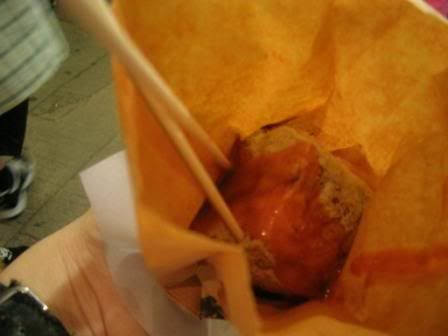
Well it does stinks before you put it into your mouth but with a little grimace you'll be able to do it and once you bite into it, you'll find it juicy and a little bit sour (from the fermentation I guess), after all its suppose to be 'spoilt', which meant so literary in Cantonese "chow", which ironically also can be meant by "smelly". Well, all said in one word, it is spoilt and smelly but yet...still delicious. Warning though, it does left a weird after taste in your mouth and you wouldn't want to go talking to anyone near for that matter!
Then there was the special or chien (fried oyster with eggs) which is entirely different from Malaysia version. This one is ultra-crispy with the eggs all fluff up with extra crunchy batter plus with generous amounts of oysters. The ones in Malaysia are usually flatter ones. But somehow, at the end of the meal, one can feel "jelak" (sick) of its richness and also partly because it is pretty oil laden. Anyhow, a must try in one of the stalls in miu kai.
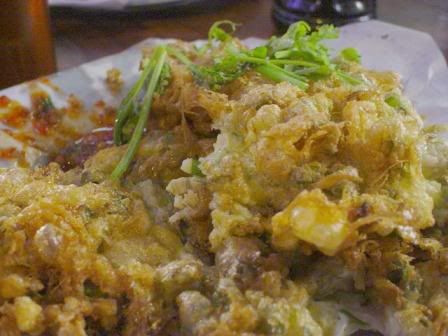
Well, you guys must be thinking, where is the dim sum!?! That’s what Hong Kong is famous for! Well, of course I do have loads of dim sum picture, I had it 3 times for breakfast and once for lunch! Imagine that!
My favorite of the lot is siu long pau (Shanghai dumpling) that is soupy inside with fresh meat and really goood to bite...I missed it so much!


Next is the Shanghai beef pau which is sweet meat in a crusty bread. Shanghai has the best dim sum I guess and they can't seem to have enough of beef.
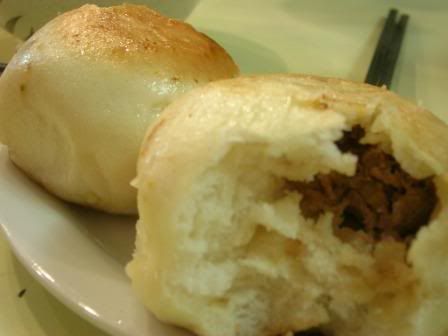
My friends and I so wanted to try the lor mai kai (steamed glutinous rice with chicken) and see the difference from the ones in Malaysia. Well it is certainly different, in fact it wasn't even called lor mai kai, I forgot what's it called but we sure had a hard time describing to the poor waitress for it! LOL
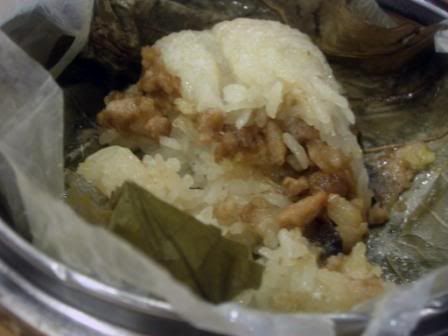
I heard that the spring rolls is a must try but to me, it is just so-so, I prefer the ones in Malaysia.
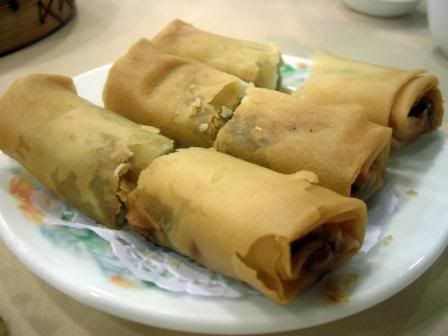
This is a char siew pau (pork meat bun), which I’m not sure what version it is but it sure is good. The bun is soft and fluffy, with honey glazed on top with the extra kick of juicy sweet and salty pork filling...yummy. It is certainly a variant from the usual steamed pau as this one is baked.
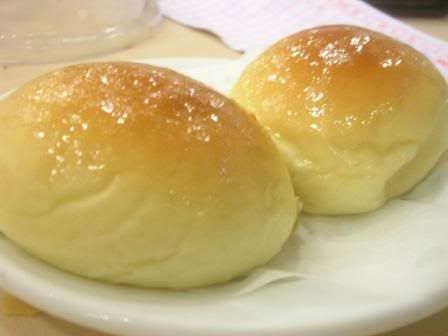
Here’s an array of one of the dim sum breakfast I had in a different restaurant. Notable ones here are the fried mango in the middle which is crunchy and sweet, really special and the package type of bean curd with filling inside which is really different and good. Sigh, I miss my dim sum fix in Hong Kong!
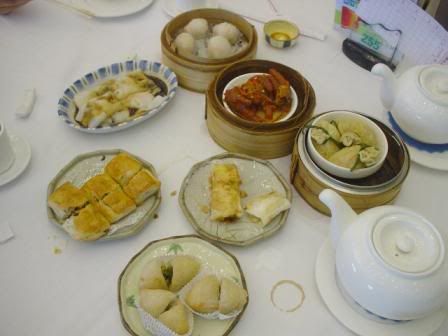
There’s this which I think is considered a dim sum dish too, which is called char leong, which is actually yau char guai wrapped with cheong fun! Really special combination but tasty nonetheless! Crunchy coupled with the smooth cheong fun...something that delights the palate indeed.

Oh, look at this grilled chicken salad...
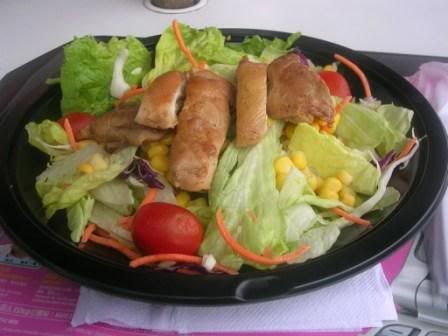
Yummy looking eh? Guess what? It is from McDonalds! The McD over there has a whole set of fresh menu where you can choose a range of salads and also flatbread with fresh meat and vegetables for more filling ones. Here’s a favourite flatbread among us, the Korean beef flatbread
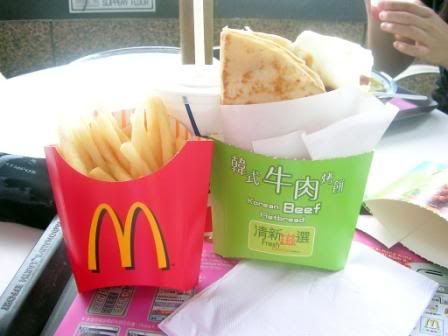
Last but not least, is this lovely tong sui (sweet dessert) that we had in one of the little shop in a corner street of Kowloon, which is actually black sesame dessert. Look how thick it is!
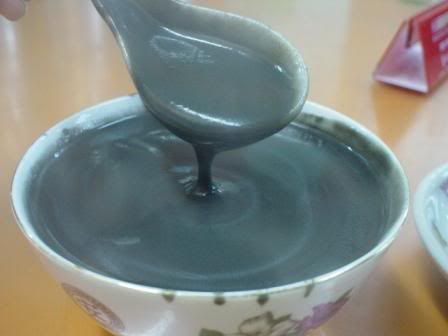
That’s all for how three girls from Malaysia eat their way through Hong Kong in 1 week. Hope you all enjoyed it as much as we did!
